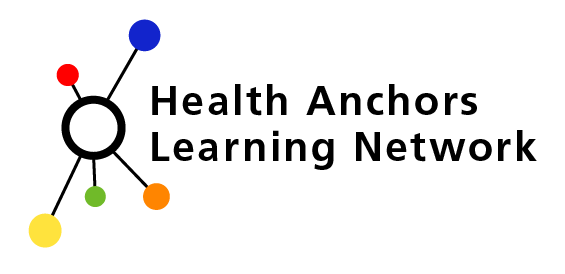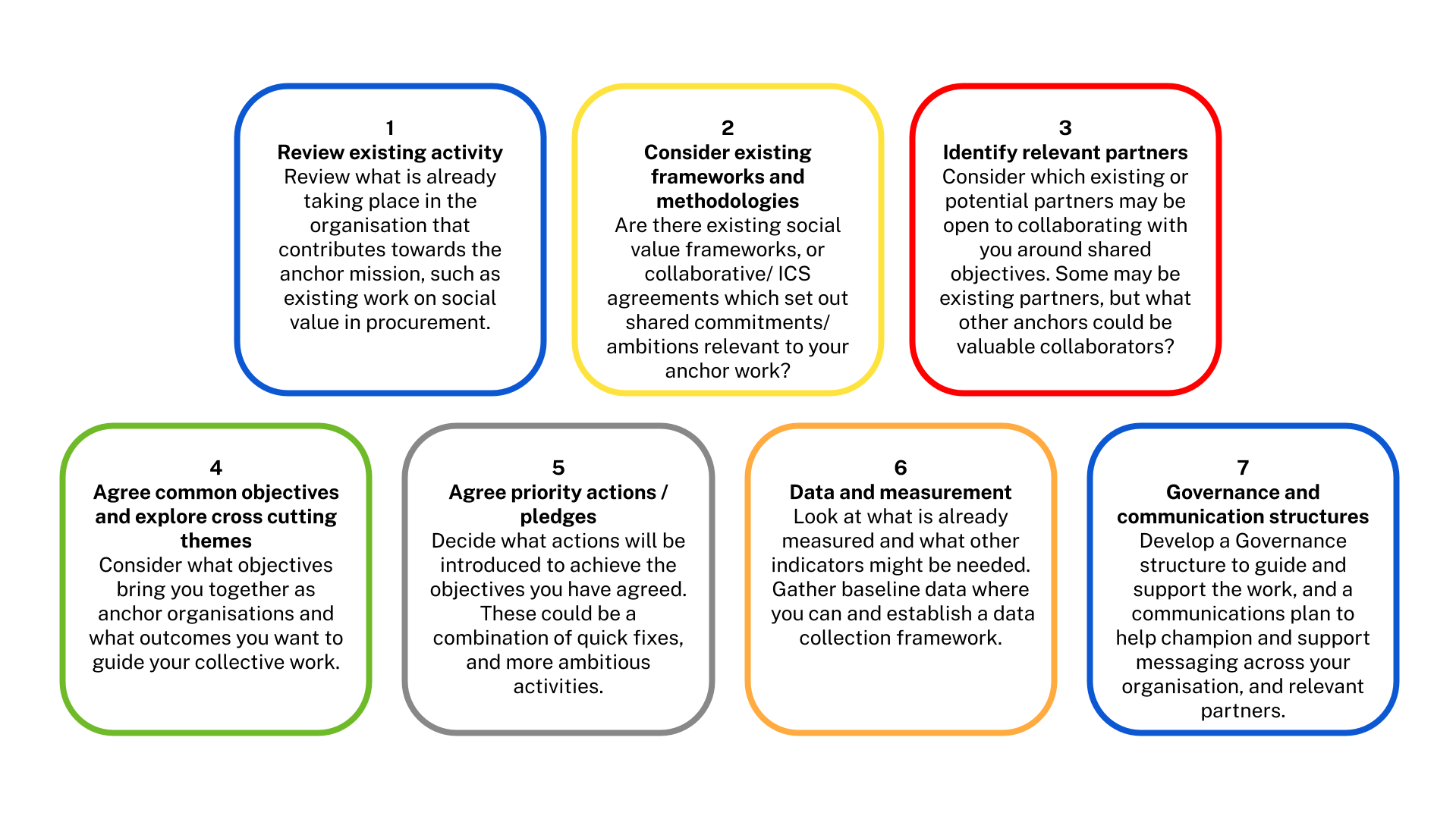Where to start with… anchor frameworks and charters
“The framework is a tool for anchors to say: ‘where are we now, where do we want to be, and what are the practical steps we can take on that journey.”
Nicky Denison, HALN Anchor Frameworks event, 2021
Earlier this year, a Health Anchors Learning Network event explored how anchor organisations across the UK have used frameworks and charters to guide their work. At the event we heard from three speakers involved in developing and testing frameworks to guide their work as well as the lessons they’ve learnt about how these frameworks can be most useful to an anchor organisation or a collaborative of anchors working together.
A range of practice is emerging across the UK: the term ‘framework’ can include self-reflection frameworks, such as the one developed in Leeds and adapted by Barts Health in London, or charters, such as the one developed by Essex, and adapted by the North East London Sustainability and Transformation Plan (STP) / Integrated Care System (ICS). We’re combining both terms here, alongside the cross-organisational anchor strategies which often use a framework approach to guide them.
1. A good framework can act as a guide for the delivery of a range of anchor strategies, reporting on progress and self-reflection / learning.
One of the main functions of an anchor framework, or charter, is to bring together a range of anchor strategies into one place and set out a picture of how they all come together across the organisation or the network (some frameworks have been developed by anchor collaboratives). So, for example, they might bring together employment, procurement, sustainability and community engagement and present a composite of the organisation's ambitions as an anchor. The framework can set out steps to progress through each strategy or priority (as shown in the example from Leeds below), as a tool to prompt reflection and learning, and as a structure for gathering data and reporting on progress - it’s about systematising and documenting the ambition of an anchor.
The Leeds framework (image 1, below), for example, was developed primarily for self-reflection so that anchors could pick it up and use it to reflect on their practice and identify areas for development. Each section is designed for specialist practitioners and breaks them down into specific themes and actions / activities that an area can take. For example, within employment this might include sections on recruitment, progression and pay and conditions.
2. Charters, and the process of developing them, can be a useful process to engage a range of partners in identifying shared priorities and making commitments to each other and to their local place.
Part of the value of creating a bespoke charter or framework to your organisation or anchor collaborative is going through the process of discussing local issues, identifying shared priorities, articulating what progress looks like and having something which can help guide teams through. It can create a shared vision for a place and be used to engage externally with other local partners too.
The Leeds charter, for example, engaged 12 anchor partners across the region in its development and set out areas for collective action for this partnership. In some cases, not all partners can sign up to exactly the same metrics / ambitions - for example, they may have very different strengths they can build on. But there are likely to be at least some areas they have in common.
3. Frameworks and charters knit together a range of themes and show the collective aspiration and intersection of anchor strategies
Some anchor strategies are aligned to specific functions - such as procurement and workforce - while others are more cross-cutting - such as sustainability or regeneration. A framework can be a helpful way to illustrate, visually, how different anchor strategies intersect and reinforce each other. It can also bring different functions together around a shared objective and show how they each contribute towards this.
The Leeds charter, for example, set out five categories covering: employment; procurement; service delivery; civic contribution and collaboration; and environment and physical assets - all bought together under the aspiration to support inclusive growth.
In some cases, such as the London Anchor Institutions Charter, anchor organisations collectively commit to applying their anchor power to specific groups of people most disadvantaged by the pandemic. In London, they chose to focus on maximising employment opportunities for these groups and supporting young people to flourish.
4. Anchor frameworks and charters can be externally focused documents which are used to share anchor aspirations with other partners and local citizens
Frameworks and charters can be helpful to share your ambitions with external partners and residents. They can become highly visual, such as Chicago’s West Side United website which shares their impact and measurement framework, or the Suffolk and North East Essex ICS Charter. Similarly, the North Ayrshire Anchor Institutions Charter includes six pillars each with an objective and a set of pledges. Making these frameworks visible and committing to specific actions and pledges can be helpful for gathering allies and raising external accountability for the work.
5. Provides a baseline to work from and setting a vision for moving from good to better and best.
Last, but not least, a good framework will set out steps that individuals and organisations can take to build on their work and take their aspirations deeper. It can also double up as a measurement framework, aligning indicators with objectives and providing a framework for a baseline set of data against key areas such as spending and employment.
Seven steps and stages in developing an anchor framework
What an anchor framework isn’t (or shouldn't be) is a static document, which once published becomes a reference point. Those participants who spoke at the HALN event talked about it being a dynamic tool which was actively used by teams and their partners.
Some of the most valuable learning from this event was the insight shared by the speakers on the steps they took to create an anchor framework or charter for their organisation. We’ve distilled these into the seven steps shared below.
One guiding nugget of wisdom was shared by a speaker involved in the Leeds framework who reminded participants to go where the energy is and build a framework around people’s commitment and enthusiasm.
Seven steps and stages in developing an anchor framework. To download the one page guide, visit our ‘Tools to get started’ page or our FutureNHS workspace.
Join our learning set on anchor charter / framework development
If you’re working on developing an anchor charter or framework in your local area you might be interested in a new learning set that the Health Anchor Learning Network is establishing. Starting in October 2021, the learning set will bring together people across the UK who are leading anchor charter / framework developments in a group to learn and share from each other’s practice. You can find out more about learning sets on our website and you can express your interest in joining in a short expression of interest form.


